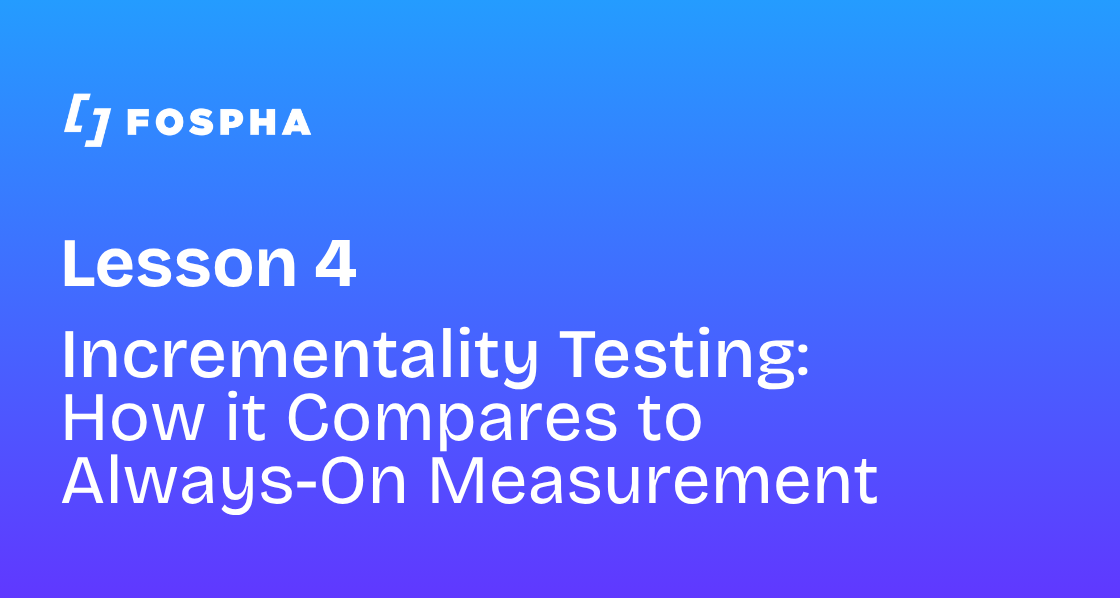What is Media Mix Modeling (MMM) and why do we take a “Bayesian” approach at Fospha?
We'll first unpack everything you need to know about Media Mix Models (MMMs), discuss the limitations of traditional MMMs, and dive into the basics behind Bayesian modeling before understanding why Fospha adopts this approach to modeling.

What are Media Mix Models (MMMs)?
As marketers, we know how difficult it is to prove the impact of our work. Revenue may be up, but is that because your new campaign landed, your competitor’s sale just ended, a piece of press coverage spiked awareness - or was it simply good timing?
Media Mix Models (MMMs) are one way to help answer these questions.
They statistically analyze your revenue (or conversions, sales, etc.) alongside data on your marketing activities and external factors - like seasonality, competitor activity, or broader economic trends - to estimate the contribution of each to performance.
Traditional MMMs are designed for annual or quarterly reporting cycles, providing analysis of long-term media effectiveness. They’re extremely valuable for strategic planning and for measuring the effect of influential external factors on business outcomes.
However, traditional approaches have some limitations for professionals trying to take granular action from their outputs - especially in fast-moving digital marketing environments where frequent optimization is the norm.
What are the limitations of traditional MMMs?
Many of the issues with traditional MMMs stem from a missing link between descriptive insights (i.e., “What did we find in the historical data?”) and actionable guidance (i.e., “How should I take action from this insight?”):
- They can only model what they can see – Traditional MMMs can only model factors for which you can provide consistent, long-term data. With no direct mechanism to incorporate insights without this, they can often be blind to valuable business context.
- They’re slower than marketers typically need – Using large volumes of data gives MMMs statistical robustness but makes them slow to report. Traditional models are refreshed quarterly or every six months, but that leaves you operating without guidance between reports (or relying upon different toolsets that may not always align well).
- They estimate causation but can’t prove it – MMMs aim to identify causal relationships between marketing and business outcomes (i.e., that your activity actually caused revenue changes) but their underlying modeling means this is only ever estimated and not proved. This can make it difficult to action their insights without extra validation - particularly if results are surprising or unexpected.
- They rarely quantify uncertainty – Traditional MMMs report a single “point estimate” of a factor’s impact (e.g., “every $1 in Paid Search drives $3.50 in incremental revenue”). However, all estimates are imperfect and the real impact could be above or below this number. Without visibility into best- and worst-case scenarios, marketers lack a full picture of the potential risk when making investment decisions from MMM outputs.
A note on Correlation vs. Causation
Most marketers have heard the phrase “correlation is not causation,” and this principle sits at the heart of many challenges with traditional MMMs.
MMMs are built to uncover how marketing influences outcomes, but they do so by identifying patterns in historical data - how these things change together over time.
However, two things can move together, but it doesn’t prove that one is causing the other. That’s why true causal validation still requires complementary methods like Randomized Controlled Trials (RCTs) or incrementality tests.
A well known example of this is the relationship between ice cream sales and shark attacks.
If we were to look at historical data on ice cream sales and shark attacks, we would find that when ice cream sales increase, the number of shark attacks also tends to increase, suggesting a strong positive correlation between the two variables.
However, clearly ice cream sales aren’t causing sharks to attack people, and shark attacks aren’t causing people to buy more ice cream. In fact they’re both driven by the fact that people buy more ice cream and go swimming more frequently in the summer.
A correlative model would tell you that increasing ice cream sales is a strong predictor of increased shark attacks, potentially leading to take incorrect actions - like stopping ice cream sales to try to prevent further shark attacks.
Thankfully, more modern approaches to MMM modelling make it possible to go beyond correlation to provide causally robust outputs.
One such approach is Bayesian modeling.
Introducing “Bayesian” MMMs
Bayesian modeling is a statistical framework that takes a probabilistic approach to estimation.
This means that, unlike traditional MMMs that output a single “best value” to describe an observed relationship (e.g., “when spend is $5k, ROI = 4”), a Bayesian model instead estimates a distribution of probable values (e.g., when spend is $5k, there’s a 90% probability that ROI is between 3.2 and 4.8”).
When applied to MMMs, a Bayesian approach introduces several key benefits that help overcome traditional limitations:
They can incorporate credible prior knowledge – Unlike traditional MMMs that demand consistent, long-term data for every factor modeled, Bayesian MMMs can directly incorporate credible prior knowledge. This ability to integrate existing insights - known as priors - allows you to include lift test results, observed behaviors, or baseline expectations directly into the model without needing years of observational data.
Imagine launching ads on Pinterest for the first time. You might not have years of data, but you do know how well your Meta prospecting tends to perform. A Bayesian model lets you start from that informed expectation and then let the data refine it.
They enable more frequent updates and faster learning – The use of priors allows Bayesian MMMs to achieve stability with less data history, enabling models to be updated more frequently, moving from quarterly or every six months, to weekly.
If your Pinterest activity is performing well and you decide to diversify into TikTok and Snapchat, a Bayesian MMMs would allow you refresh the model almost immediately, giving you credible, updated performance measurement for emerging channels without waiting for the next quarterly report.
They can be calibrated with causal evidence – Priors also provide a mechanism for moving an MMM from purely correlational findings to causal truth. By feeding the results of incrementality tests directly into the Bayesian model as priors, you essentially calibrate the MMM’s inferred relationships with experimentally validated causal evidence. This ensures the model's outputs are more robust and can be better trusted to represent true, incremental findings.
Now let’s imagine that your most recent MMM output is showing an exceptionally high, and likely inflated, attribution for an established channel - suggesting the model is capturing a correlation rather than true, incremental impact. To isolate the true value, you can run a targeted incrementality test and integrate the causal findings back into the Bayesian model as a prior. The model will immediately recalibrate its long-term correlational attribution estimate to align with this causal truth.
They help quantify and manage risk – Instead of offering a single number to estimate impact, Bayesian MMMs present a full probability range for each output (known as a credible interval). This allows marketers to see best- and worst-case scenarios before acting.
For example, if your Bayesian MMM predicts a 3x ROI for TikTok with a 90% credible range between 1.5x and 4.5x, you can plan your spend knowing the potential worst-case scenario - and decide if that’s a risk worth taking.
These benefits are why many advanced measurement practitioners are adopting Bayesian modeling as the preferred approach for MMMs in a privacy-first world. Fospha's incremental forecasting tool, Beam, leverages the benefits of Bayesian modeling to forecast the incremental return of spend on revenue, supporting real-time risk-aware optimizations.
At a glance: How Bayesian MMMs differ from traditional approaches
.png)
Model validation: The real test
No model - even one built on Bayesian principles - should be trusted blindly. Hidden statistical issues like instability or overfitting can make a model look great on paper but fail completely when applied to real-world data.
That's why validation is the most critical step in using MMMs effectively. Validation stress-tests your model's predictive performance in the real world, giving you confidence that it doesn't just fit historical data - but actually works for future decisions.
There are two methods generally considered to be the core pillars of MMM validation: backtesting and experimentation.
- Backtesting – In backtesting, a portion of historical dataset is hidden from the MMM during development. We then check the model’s outputs against this data to simulate how the MMM would be applied in the real world. If the outputs turn out to be inaccurate, we know that the model is unlikely to be reliable and we can fix issues before costly error occur.
- Experimentation – Validation via experiments are a crucial check of how well the model’s correlational findings align with causal evidence from incrementality tests. Although Bayesian MMMs have mechanisms to move beyond correlation to causation described above, experiments remain the gold standard for causal proof. Alignment between MMM outputs and test results gives you the best possible evidence for reliability.
Fospha's Bayesian model outputs are continuously back tested and monitored for these reasons, and all customers receive dedicated test design support from their dedicated Customer Success Coordinators and Account Manager.
The bottom line
Media Mix Models (MMMs) are powerful tools for estimating the contribution of marketing activity, but traditional approaches have struggled to translate those insights into timely, actionable decisions.
Bayesian MMMs - built on probabilistic modeling - provide mechanisms to mitigate these limitations by incorporating prior knowledge, quantifying uncertainty, and aligning with causal validation techniques.
While traditional MMMs still have their place, particularly when used intelligently alongside other measurement methods, Bayesian approaches represent a significant evolution - helping marketers move from static reporting to a more dynamic, evidence-based framework for decision-making.
In the next lesson, we’ll look at the wider marketing measurement landscape - exploring the main categories of measurement, their strengths and limitations, and when each approach is most useful.








